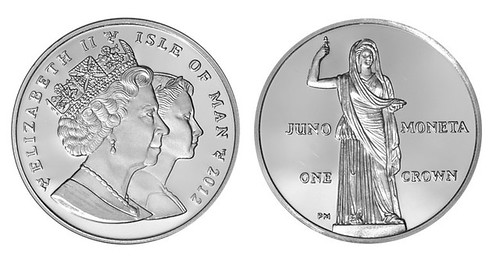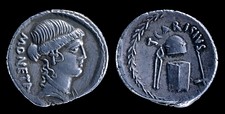
PREV ARTICLE
NEXT ARTICLE
FULL ISSUE
PREV FULL ISSUE
JUNO MONETA, GODDESS OF MONEY
P.K. Saha forwarded this information about a new coin from the Isle of Man featuring the goddess of money, Juno Moneta.
-Editor

The word money comes from the Latin word moneo, which means ‘ to warn’, and is named after the Roman Goddess, Juno Moneta. Juno, in Roman mythology, was the wife of Jupiter and as such was considered the Queen of Gods and the most powerful goddess. She was originally the Goddess of marriage and childbirth, the protectress of women, the patroness of matronly virtues and the patron Goddess of Rome. In 390BC, a flock of geese kept in Juno’s sanctuary on Capitoline Hill, saved Rome by warning of an impending invasion by the Gauls. The Roman General, Marcus Furius Camillus, built a temple on the hill in gratitude for the Goddess’ warning. Approximately one hundred years later, the first Roman mint was built adjacent to the temple and the coins, struck with the head of Juno Moneta on the face, were called ‘moneta’. She has since been considered the protector of money and guardian of finances. In light of the above, Juno Moneta is the perfect choice to feature on this commemorative coin. The design on the coin features a portrait of the Goddess interpreted from a classical statue. The coin features a specially commissioned Double Effigy of Her Majesty Queen Elizabeth II to celebrate her Diamond Jubilee year which shows a portrait of Her Majesty as she appears on current coins, along with a portrait of the Queen based on how she appeared on the first coins of her reign. The coin is Copper-Nickel , 38.8mm
While looking for more information I found this page from the British Museum on a Silver denarius from 46 BC showing Juno Moneta.
-Editor
This coin shows an image of Juno Moneta on the front; her name is written vertically on the left. On the back of the coin are depicted tools associated with metalworking: in the centre an anvil, on the left a pair of tongs and on the right a hammer. Above the anvil is an uncertain object decorated with a wreath. It may be the smith's cap worn by Vulcan, the Roman god of fire and metalworking. Alternatively, the tools shown may be those of an ancient Roman coin-maker, if we interpret the 'cap' as an upper die about to be struck by the hammer onto a blank held by the tongs. The coin was made by the moneyer Titus Carisius.
To read the complete article, see:
Silver denarius showing Juno Moneta
(www.britishmuseum.org/explore/highlights/highlight_objects/ The Numismatic Bibliomania Society is a non-profit organization promoting numismatic literature. See our web site at coinbooks.org. To submit items for publication in The E-Sylum, write to the Editor at this address: whomren@gmail.com To subscribe go to: https://my.binhost.com/lists/listinfo/esylum All Rights Reserved. NBS Home Page Contact the NBS webmaster 
|
